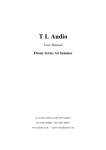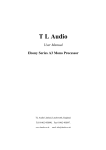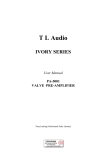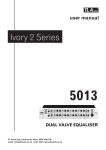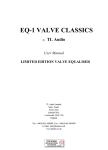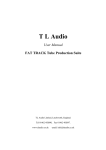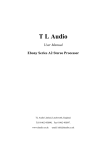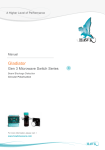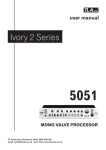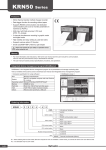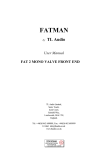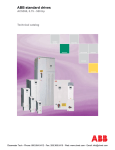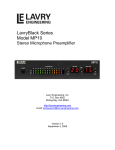Download A1 - TL Audio
Transcript
T L Audio User Manual Ebony Series A1 Dual Pre-Amp TL Audio Limited, Letchworth, England. Tel 01462 492090, Fax 01462 492097. www.tlaudio.co.uk email: [email protected] TABLE OF CONTENTS TABLE OF CONTENTS.............................................................................................................................. 1 INTRODUCTION ......................................................................................................................................... 2 WHY CLASS-A?............................................................................................................................................ 2 WHY TUBES?................................................................................................................................................ 3 WHY BALANCED I/O?.................................................................................................................................. 3 THE A1 DUAL PRE-A MP.............................................................................................................................. 3 PRECAUTIONS ............................................................................................................................................ 5 BLOCK DIAGRAM...................................................................................................................................... 6 INSTALLATION........................................................................................................................................... 7 AC Mains Supply. .................................................................................................................................... 7 Audio Inputs............................................................................................................................................. 7 Instrument Inputs..................................................................................................................................... 8 Outputs. .................................................................................................................................................... 8 Ventilation................................................................................................................................................ 8 OPERATION. ................................................................................................................................................ 9 Microphone Input .................................................................................................................................... 9 Instrument Input ...................................................................................................................................... 9 Input Gain. ............................................................................................................................................... 9 30dB Pad Switch...................................................................................................................................... 9 Phantom Power. ...................................................................................................................................... 9 Tube Stage Drive and Peak LEDs........................................................................................................ 10 Output Peak LED. ................................................................................................................................. 10 GETTING STARTED ................................................................................................................................ 11 Mic Input:............................................................................................................................................... 12 Instrument Input: ................................................................................................................................... 12 High Pass Filter: ................................................................................................................................... 12 Output Gain: .......................................................................................................................................... 12 Output: ................................................................................................................................................... 12 Tube Stage: ............................................................................................................................................ 13 Metering:................................................................................................................................................ 13 Power Requirements: ............................................................................................................................ 13 Dimensions: ........................................................................................................................................... 13 SERVICE ...................................................................................................................................................... 14 1 INTRODUCTION New from TL Audio, The Ebony Series is a sleek looking range of discrete Class A processors designed to heighten your audio experience. The range consists of 3 units, all of which use Discrete Class A circuitry and have an optional tube stage with variable drive putting you in control of how ‘creamy’ or how ‘cool’ your unit sounds. Hand assembled in England to the highest standards, the Ebony uses stylish, quality chrome knobs together with a high gloss black finish to make the exterior look just as smooth as the circuits sound. The Ebony Series have all the features you come to expect with TL Audio, including balanced I/O, multi input options, analogue VU metering and intuitive, precise controls. All units are also compatible with the TL Audio DO-2 digital SPDIF interface for easy digital connectivity with high quality conversion. A combination of supreme quality, unrivalled sound and stylish aesthetics - this range offers superior analogue processing to accompany a digital world. Why Class-A? Class A circuits are designed with a constant current flowing through all of the transistors, which is sufficient to drive the peak output required from each block of the circuit. This ensures that every transistor is kept at its optimum operating point, minimising non-linearities due to changes in current and internal thermal effects, and eliminating the objectionable “cross-over” distortion typical of class AB circuits. Due to the higher steady state (or “quiescent”) currents used, the power dissipation of class A circuits is substantially higher than can in general be handled by integrated circuits. It is also possible to design discrete transistor circuits to operate at higher voltage rails than are available for audio integrated circuits, adding the benefit of greater headroom and improved dynamic range. For these reasons, there are no integrated circuits in the audio paths of the Ebony Series. The outstanding audio quality is reflected in the technical specification of the units, with particularly low noise and distortion, and wide frequency response. 2 Why Tubes? Valves - or “Tubes” - have long been associated with excellent audio quality, recognised as adding “warmth” or “depth” to a signal. Driving the valves harder results in an increasing level of mainly second harmonic distortion, which is responsible for the characteristic overdriven valve sound. The Ebony Series feature variable drive valve circuits, which may be switched into the audio paths, or bypassed completely. The valve drive control varies the signal level through the valve stage, without affecting the overall gain from input to output. It is therefore possible to vary to the degree of harmonics added by the valve, from subtle warming to crunchy overdrive, with a single control. The signal level through the valve is displayed by the variable intensity “Drive” LED and the “Peak” LED. Where instrument inputs are present on the Ebony models, dedicated valve input stages are used. Switchable to high or low sensititivity (and impedance), these input stages represent the ultimate quality for the first stage of instrument amplification. Why Balanced I/O? Balanced I/O (Inputs and Outputs) are always preferable to unbalanced connection in an audio system. A balanced signal consists of signal phase and non-phase connections, which form a differential pair, independent of the ground (or earth) connection. Noise, particularly mains hum and high frequency interference can often be present in unbalanced systems due to small differences in ground potential or circulating ground currents (“loops”) between units, where the signal phase (only) is taken as an absolute value with respect to ground. A correctly designed balanced interface should have both phase and non-phase signals of equal magnitude (and source impedance), but should allow either of the phase and non-phase signals to be connected to an arbitrary electrical point (e.g. ground) without changing the differential level. Therefore, if, for instance, the non-phase signal is shorted to ground by an unbalanced input on a piece of equipment, then the phase signal should double in magnitude to compensate. Such an arrangement is referred to as “floating” or “ground-free”. Balanced signals require 3 pin connectors, such as XLR’s or TRS jack plugs, carrying the phase and non-phase signals, plus a screening ground connection. Naturally, the Ebony Series features balanced, ground-free signals for all line inputs and outputs, as well as insertion points where present. The range is also compatible with unbalanced equipment, as described above. The A1 Dual Pre-Amp. The Ebony Series A1 Pre-Amp features two independent channels, with each channel offering mic and instrument inputs. 3 The block diagram of one of the channels is shown in fig.1. A discrete Class A electronically balanced mic input amplifier is used, delivering superior audio performance with very low noise, low distortion and wide bandwidth. The mic input is suitable for low impedance (150-600 ohm) microphones, with a gain control range of +16 to +60dB. Front panel switches provides 48V phantom power, and 30dB pad for high output mic applications. The front panel mounted jack socket is suitable for a variety of sources, including electric guitar, acoustic pickup and keyboard. The instrument input has high/low switching, and a dedicated valve input stage. Phase reverse and high pass filter switches are provided, affecting both mic and instrument inputs. The tube stage has a variable drive control, with the signal level indicated by the variable intensity “Drive” LED and “Peak” LED. Use of this feature typically introduces 1% to 10% harmonic distortion, predominately second harmonic, without changing the output level from the unit. The tube stage can be selected or bypassed as required. A VU meter is provided, which can be selected to either channel, and input or output signals. The meter is also provided with a “+10dB” switch, which keeps the reading on the scale when driving a high level out (to a DAW, for example). In the +10 mode, 0VU is calibrated as +14dBu out. Please read this manual fully before installing or operating the Pre-Amp. 4 PRECAUTIONS The T L Audio Ebony Series units require very little installation, but like all electrical equipment, care must be taken to ensure reliable, safe operation. The following points should always be observed: - All mains wiring should be installed and checked by a qualified electrician, - Ensure the mains operating voltage stated on the rear panel is correct before connecting to the mains supply, - Never operate the unit with any cover removed, - Do not expose to rain or moisture, as this may present an electric shock hazard, - Replace the fuse with the correct type and rating only. Warning: This equipment must be earthed. 5 BLOCK DIAGRAM. 6 INSTALLATION AC Mains Supply. The unit is fitted with an internationally approved 3 pin IEC connector. A mating socket with power cord and mains plug is supplied. All mains wiring should be performed by a qualified electrician with all power switched off, and the earth connection must be used. Please note that when using this unit with alternate supply voltages (in foreign countries, for example) the internal wiring of the unit may be set for 115V (accepting voltages in the range 110V to 120V, 60Hz AC) or to 230V (for voltages in the range 220V to 240V, 50Hz AC). If the wiring needs to be changed, the unit must be taken to an approved service centre. Alternate supply voltages may also require a different power cable or mains plug. If in doubt, consult local electrical regulations. Warning: attempted operation on the wrong voltage setting, or with an incorrect fuse, will invalidate the warranty. Audio Inputs. Each channel has a female, 3 pin XLR connector, for connection to a microphone. The microphone will normally be balanced, but unbalanced connections may also be made as follows: Balanced inputs: - Pin 1 = Ground (screen). - Pin 2 = Signal Phase (“+” or “hot”). - Pin 3 = Signal Non-Phase (“-” or “cold”). Unbalanced inputs: - Pin 1 = Ground (screen) - Pin 2 = Signal Phase (“+” or “hot”). - Pin 3 = Signal Ground. When using unbalanced signals, the signal ground may be obtained by linking pins 1 and 3 in the mating XLR connector. Do not leave pin 3 open circuit, as this may result 7 in a loss of level and/or increased noise. Good quality screened cable should be used, particularly for microphone or low level sources, to prevent hum or noise pickup. Instrument Inputs. A 2 pin (mono) jack plug is required, which should be wired as follows: - Tip = Signal Phase (“+” or “hot”). - Screen = Ground. Outputs. The outputs are via balanced, 3 pin male XLR connectors. The mating connectors should be wired as follows: - Pin 1 = Ground (screen), - Pin 2 = Signal Phase (“+” or “hot”), - Pin 3 = Signal Non-Phase (“-” or “cold”). If an unbalanced output is required, pins 1 and 3 should both be connected to ground. Ventilation. The unit generates a moderate amount of heat internally, which should be allowed to dissipate by convection through the grills in the sides and front panel, which must not be obstructed. Do not locate the unit where it will be subject to external heating, for example, in the hot air flow from a power amplifier or on a radiator, or in direct sunlight. The unit may be free standing, or mounted in a standard 19” rack. 8 OPERATION. Microphone Input The 2 XLR mic inputs are at the rear of the Ebony A1. Virtually any low impedance professional microphone can be used. Condenser microphones will require the 48V phantom power button to be engaged for correct operation, but before using Dynamic and Ribbon microphones ensure that the phantom power is switched off. Instrument Input The front panel instrument input socket is suitable for low level sources such as hi impedance microphones, pick ups or passive guitars, and higher level sources such as active guitars and keyboards, as it is switchable to high or low sensitivity. Input Gain. The gain of the mic preamp stage is variable from +16 to +60dB. This is a very wide range, to cater for all types of microphone and recording situations, but care must be taken not to apply large, sudden changes in gain that may result in unexpectedly large output signals. It is quite normal to have to apply larger amounts of gain for less sensitive microphones, such as dynamic types, and similarly apply much less input gain for high output condenser mics: some of which may even need the 30dB pad activated when recording very loud sources. 30dB Pad Switch. Occasionally - when using sensitive condenser microphones - the source signal may be too loud for the input preamp. In this situation, to avoid any overloading or distortion of the mic preamp stage, the 30dB pad can be used to reduce the input gain to a more manageable level. The 30dB pad only applies to the microphone input. Phantom Power. +48V phantom power is available at the mic socket, selected by a front switch. Phantom power should only be used in conjunction with suitable microphones. CAUTION: Operation of the phantom power switch, or plugging a microphone in or out with phantom power applied, may cause a click or thump in your loudspeakers. To prevent this happening, ensure that the system gain is set to minimum (e.g. on your mixing console fader or power amplifier), before operating the switch or plugging in a microphone. 9 Tube Stage Drive and Peak LEDs. These LEDs indicate the drive level to the tube, or valve, stage. The Drive LED is a variable intensity indicator, starting to glow when the tube harmonic distortion is around 1%, and being fully illuminated at approximately 5% harmonic distortion. The distortion is predominately second harmonic, unless very high drive levels are used, in which case the tube is eventually pushed into harsher saturation, indicated by the tube Peak LED. Output Peak LED. Each channel has an output Peak LED adjacent to the VU meter. These LEDs complement the average reading VU meter, and are useful for monitoring the output prior to sending to a DAW, for example. The Peak LEDs illuminate at an output level of +19dBu. 10 GETTING STARTED 1. Having powered up the Ebony A1 and ensured all the gain controls are at minimum connect its line output to the desired line input on your console, recorder or sound card. Avoid connecting the line output of the Ebony A1 to the microphone input of a console or soundcard - this could well result in level and impedance mismatches, with a resultant loss of quality (but is easy to do in error since both normally use the same type of 3 pin XLR connector!) Aim for a balanced XLR to jack cable to connect into your console or soundcards line input. 2. Ensure that the console, recorder or sound card has its input gain set to a sensible level (0dB is a good starting point). 3. Then connect the desired mic or instrument source to the relevant Ebony A1 input (microphones will use the rear panel XLR and instruments will use the front panel 0.25” jack). 4. If a condenser microphone is the sound source, then depress the +48V phantom power switch. You may see a transient thump register on the Ebony A1 meters as you do this (which is why it is important to have the gains at minimum). Then gradually bring up the Ebony A1 input gain level until the signal starts to register a healthy reading on the VU meter. When the tube stage is ‘IN’ and you also turn up the ‘warmth’ control, the Drive LED starts to glow as the mic or instrument are used. 5. Now bring up the Ebony A1 output level control - you should now start to hear some sound, and as the output is increased the red signal LEDs will start to illuminate. Set the output level to a comfortable level so that you are getting a good metered level on the piece of equipment the Ebony A1 is driving into. Remember that some digital recorders and sound cards require a large amount of level to fully modulate their meters, so you may need to apply a significant amount of output gain to do this successfully. By contrast a standard analogue console will require much less level. Please beware not to let the signal ever clip (go into the red) on your DAW input (Logic, Pro Tools, Cubase etc). Clipping will cause digital distortion which a square wave and signal degradation. 6. Experiment with the 90Hz filter - you should notice how it removes extreme LF content (particularly noticeable on close-miked male voices) and the 30dB pad will reduce the signal level quite markedly. The pad is only normally used on very loud sources where even minimum gain settings will drive the Ebony A1 preamp into distortion. The phase reverse switch should have no real effect unless you are using multiple mics through the Ebony A1 and some phase cancellation is occurring. 7. Experiment with the tube warmth rotary knob. Turn the rotary knob level up so that the Drive LED glows brighter - you should notice an audible change in sound character as the tube stage is driven harder. This variation in tone is one of the great strengths of the Ebony A1 - you have the option of running it very clean, or nice and warm as you increase the valve drive via the ‘Tube Warmth’ control. 11 SPECIFICATION. Mic Input: Discrete Class A circuitry from input to output (unless Tube stage In). Gain Range: +16dB to +60dB (-14dB to +30dB with pad), Maximum Input level: +10dBu (without pad), +30dB (with pad), Frequency Response: 10Hz to 40KHz, +0, -0.5dB, @ 40dB gain, Distortion (THD + Noise): 0.025%, 20Hz to 20KHz @ 40dB gain, Noise (EIN): -127dBu unweighted, 22Hz to 22KHz, 150 ohm source termination. Instrument Input: Tube input stage, plus discrete Class A circuitry to output. Gain Range: +8dB to +40dB (“High”), -10dB to +22dB (“Low”), Input Impedance: 1Mohm (“High”), 70Kohm (“Low”). High Pass Filter: -3dB @ 90Hz, second order. Output Gain: Maximum Gain +15dB. Output: Maximum Level: +22dBu (2Kohm load), +26dBu (10Kohm load), Noise at minimum gain: -90dBu (22Hz to 22KHz). 12 Tube Stage: Typical Distortion: 1% to 10%, depending on “Drive” level, predominately second harmonic. Noise: -80dBu (22Hz to 22KHz), output gain @ 0dB. Metering: Tube “Drive” LED: Variable intensity over 10dB level range, typically corresponding to 1% to 5% THD. Tube “Peak” LED: Dependant on level and drive, typically corresponding to 10% THD. Output “Peak” LED: +19dBu on output. VU Meter: Switchable to Channel 1 or 2, and Input or Ouput. Nominal calibration: 0VU = +4dBu. +10dB switch calibration: 0VU = +14dBu. Power Requirements: Internally set to 230V 50Hz or 115V 60Hz operation, Detachable IEC power cord, Power consumption 34VA. Dimensions: 2U, rack mounting or free-standing. W x H x D = 483mm x 88mm x 200mm (19.0” x 7.9” x 3.5”), behind front panel. Shipping weight: 6Kg. The above specifications are typical values, and do not represent limits for any particular unit. These specifications are subject to change without notice. 13 SERVICE Should the unit require service, it must be taken or posted to an authorised dealer with a description of the fault. Please retain the original packing for possible future use, and ensure the unit is suitably protected during transit. The manufacturer cannot accept responsibility for damage caused during transportation. This equipment is supported by a limited warranty for a period of one year from the date of purchase. During this period, any faults due to defective materials or workmanship will be repaired free of charge. The warranty excludes damage caused by deliberate or accidental misuse, tampering, operation on the incorrect mains voltage, or without the correct type and value of fuse fitted. It is the user’s responsibility to ensure fitness for purpose in any particular application. The warranty is limited to the original purchase price of the equipment, and excludes any consequential damage or loss. Please record the following details, and retain proof of purchase date: Serial Number............................. Date purchased........................... Dealer......................................... TL Audio Limited, Letchworth, England. Tel: 01462 490600. International +44 1462 490600 Fax: 01462 490700. International +44 1462 490700 www.tlaudio.co.uk email: [email protected] 14















